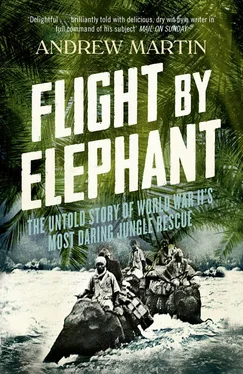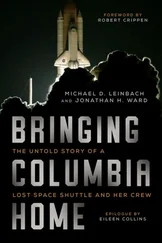John Lamb Leyden was born into a distinguished Scottish family, and was a descendant of another orientalist, John Leyden (1775–1811), poet, physician and antiquary, who ran the Madras General Hospital and held various official posts in Calcutta. Ominously for John Lamb Leyden, his ancestor died of fever on an expedition to Java.
We have a photograph of John Lamb Leyden on his trek – probably taken by Millar after Leyden had taken his . It shows a cerebral looking man with swept-back, receding hair. At thirty-eight, Leyden was younger than Millar, but looked older. Next to him, a bamboo fire smoulders thickly. He and Millar would light these at every camp, hoping the smoke would attract the planes that periodically flew overhead, but as Millar wrote, ‘… on each occasion failure to observe us was apparent’. They had no tents, so every evening they spent a couple of hours building a hut of the type known locally as a basha.
How do you build a basha?
In a lecture entitled ‘Keeping Fit in the Jungle’, given to the Bengal Club of Calcutta in early 1943, Captain Alastair Tainsh explained:
The way to keep fit in the jungle is exactly the same as anywhere else. All one needs is sound sleep, clean water, a reasonable diet, and a liberal use of soap and water. But how is sound sleep to be obtained? Well, one must learn how to make oneself comfortable in the worst conditions. It is not being tough or clever to sit in the open all night … The easiest form of shelter to build is made by fixing two upright poles in the ground eight or nine feet apart. To the top of these is bound a long bamboo making a frame like goal posts. The roof is made by leaning a number of poles against the top bar forming an angle of about 45 degrees with the ground. A number of parallel bamboos are tied to the sloping poles and into this framework banana or junput leaves are thatched.
Then you had to build a chung, or sleeping platform, to keep the leeches off, and sometimes Millar and Leyden couldn’t be bothered to do any of this, so they’d sleep in the crooks of trees. They always kept a fire burning in case a tiger should turn up, although as Millar wrote, about a week into their trek: ‘… this stretch of country is uninhabited for over a hundred miles. Not only is there not a trace of man, but mammal and even bird life is conspicuous by its absence; truly a forgotten world, where solitude reigns supreme.’
Here, too, we can invoke the voice of reason himself, Captain Tainsh:
Nearly everyone is a little frightened when they hear they must work and live in the jungle. The word ‘jungle’ conjures up in their minds a place literally swarming with lions, tigers, elephants and snakes. Nothing could be further from the truth, because wild animals and even snakes need food, and such wild animals as there are, live on the edge of cultivation, and are seldom seen in the thicker parts of the forest.
The larger animals are particularly scarce in the monsoon, when they retreat to the margins of the jungle, to avoid the leeches and mosquitoes that proliferate in the rains. Against these torments, Millar and Leyden slept with their heads wrapped in blankets but still Millar wrote, ‘Of the leeches, blister flies and sandflies I cannot give adequate description, sufficient it is to say that we were getting into a mess.’ For most of the nights, they didn’t sleep at all, but just listened to the sound of rain drumming on palms or bamboo. In the morning, the rising heat of the day made clouds of steam rise up from the muddy jungle floor like smoke from a bonfire.
By 26 May, with nine of their fourteen days of food gone, there was no sign of the Dapha river, and Millar and Leyden were down to one cigarette tin of rice per man per day.
Why had these men entered the Chaukan Pass?
To escape something worse coming from behind.
The Languorous Dream The Languorous Dream The Dapha River The Red-Hot Buddhas The Man in the River Beyond Mandalay The Railway Party The ‘Chaukan Club’ Sets Off The Footprint The Man With Elephants The Boy Who Took Acidalia trigeminata Sir John Meets the Commandos The Wizard’s Domain A Bad Start for Mackrell War And Tea (Part One) War And Tea (Part Two) Captain Wilson Sets Out Elephant Trouble for Mackrell Mackrell Reaches the Dapha River Sir John Encounters His Principal Enemy The Man in Sunglasses Mackrell Consolidates at the Dapha River Captain Wilson Arrives at the Dapha Havildar Iman Sing The Commandos Despair of Reaching the Dapha Grand Tiffins and the Squits The Drop Momentous Decisions Mackrell Returns Temporarily to Civilization Mackrell in Shillong and Calcutta The Society of Tough Guys A Face Like Wood: Dharramsing Decides A Delivery of Mail A Long Wait Subsequently (Part One) Subsequently (Part Two) Late Period Mackrell Select Bibliography Acknowledgements About the Author Praise Also by Andrew Martin Copyright About the Publisher
On the morning of 7 December 1941, the Imperial Japanese Navy attacked the American Pacific Fleet at Pearl Harbor and entered the Second World War. They wanted ‘Asia for the Asiatics’, and for the Japanese especially. During the ensuing offensives – which have been called ‘the biggest land grab in history’ – some Japanese soldiers carried a postcard to be filled out and sent home at a moment of leisure. It showed a cartoon of a Japanese soldier with a blank space where the face ought to have been. The sender inserted a photograph of himself, thus becoming the depicted soldier, who held two grinning children in his arms while a further two clung onto his knee-high puttees. The children – who waved the Japanese flag with their free hands – represented Malaya, the Pacific islands, China and the Dutch East Indies. Japan had appropriated eastern and central China in 1938. They would ‘liberate’, as they liked to put it, the British colony of Malaya in March 1942. By the end of that month, New Guinea, largest of the Pacific islands, had been taken, and the Dutch East Indies had surrendered. No child represented the British colony of Burma, but that, too, was taken by the Japanese in early 1943.
That Burma did not have a child of its own shouldn’t surprise us. It tended to be slighted in this way. Whereas Queen Victoria was, from 1877, the Empress of India, Burma was merely given to her as a ‘New Year’s Gift’ in 1886. She never went to Burma, but then she never went to India either. She didn’t like ‘trips’. The British had annexed Burma in 1886, following the third Anglo-Burmese War. There had been territorial disputes on the Burma–Assam border, and the British were concerned at French ‘interference’ in the country. The British occupied Burma from the south and the west. They did not enter Burma from Assam, simply because there were no roads into Burma from Assam.
Prior to 1937 – when Burma was given a measure of self-government – Burma was by far the largest of the ten provinces of British India, but only two of those provinces had a smaller population. On the eve of the Second World War, seventeen million people inhabited a country as big as France and Belgium combined. To the British, it was like the field a householder buys to stop anyone building too near his own property, the property in this case being India.
The Encyclopaedia of the British Empire: The First Encyclopaedic Record of the Greatest Empire in the History of the World , Volume 2 (1924), is very pleased with the utility of Burma. The country
… forms the frontier with China, French Indo-China and Siam on the east, and the province of Assam in the north. Strategically, this province [Burma], which is often termed ‘Further India’ is of considerable importance. It forms the east and north east coasts of the Bay of Bengal, and completes the semi-circle of British territory which encloses this great ocean highway to India. It was not conquered and annexed because of any premeditated plan of Imperial extension, but rather as a safeguard to India proper.
Читать дальше












